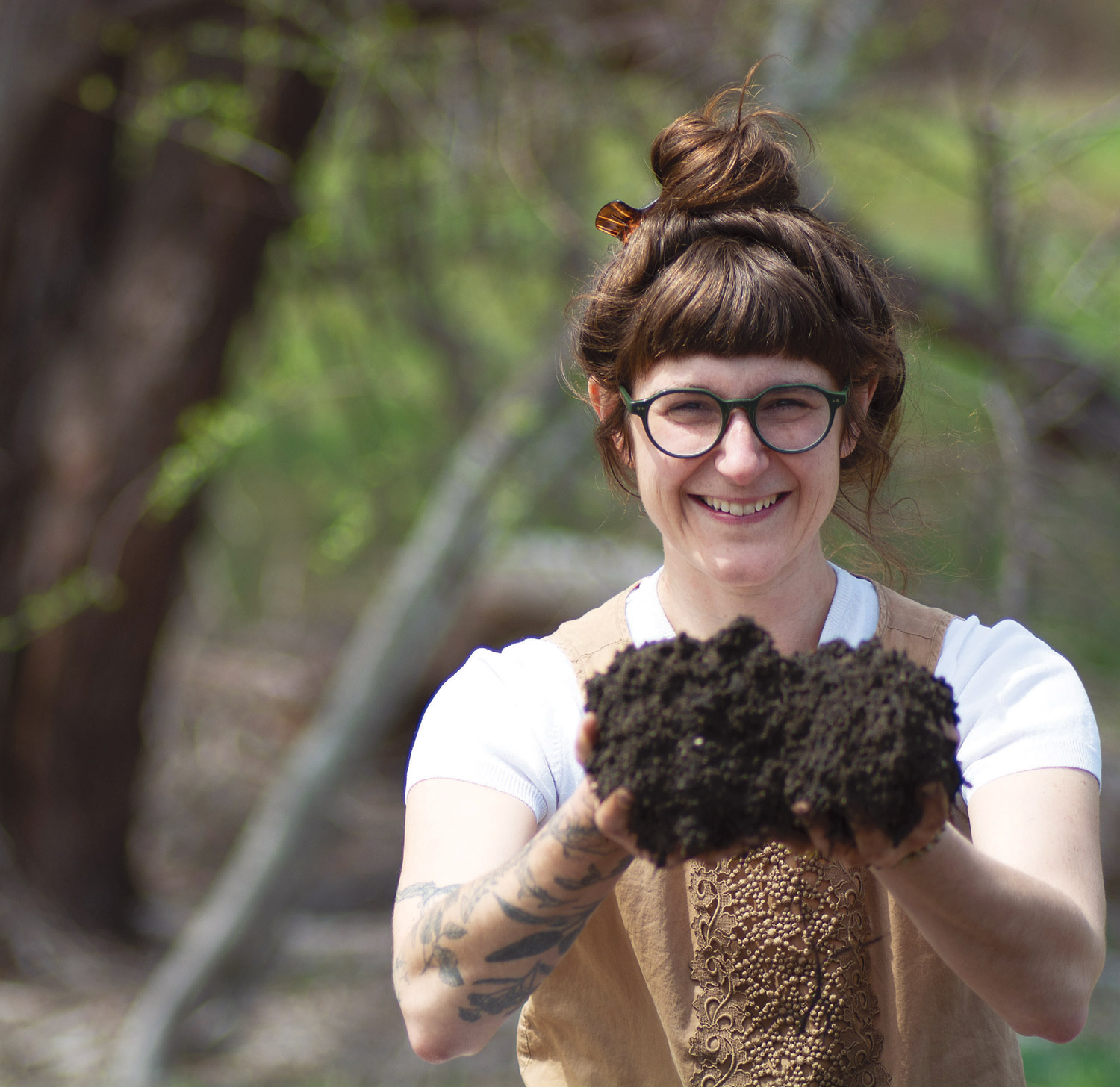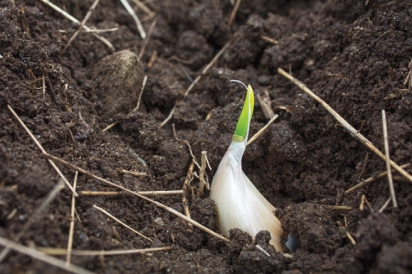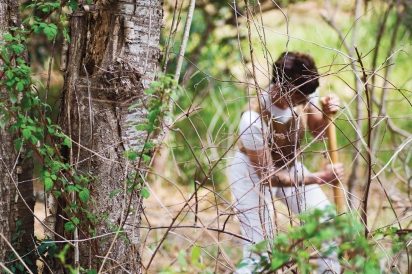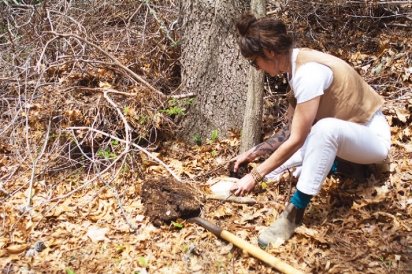Feed The Soil
And Tomatoes Will Follow
It’s not what she saw, but how she saw it. When Nicole Cormier considered the soil, its makeup and purpose, observing and appraising it through the eyes of the nutritionist and dietician that she is, Cormier realized that she was seeing the same sort of microbiome that inhabits the human digestive system. She deduced that the collection of microbes that colonizes our colon and teems in our intestines, breaking down food, extracting nutrients and passing them along to the bloodstream, is almost identical in process and importance to the living soil that makes nutrients available to a plant’s root system.
Cormier heads up Delicious Living Nutrition, her company in Orleans, focusing on nutrition. Through its offering of classes and workshops, catering, consulting, internships, selection of teas, tinctures, and dried herbs, prepared food, CSAs, and a local food cooperative, the company’s ultimate goal is to create a positive relationship with food. The aforementioned soil observation led Cormier to devise a project for her internship program to produce an organic fermented fertilizer called Cape Cod Ferments. Made from fish waste retrieved locally, the fertilizer’s recipe is so simple to make that anyone can do it in their own backyard. It’s a notion that lights up Cormier’s face.
“I’m not doing this to make money,” she said. “It’s an educational project for my dietetic interns, but I am excited to see it grow grassroots-style. The fertilizer will be offered at the Delicious Living Nutrition local food cooperative in Orleans, but it’s really a hands-on project for interns to connect with so many parts of nutrition, including microbiomes, farming, and fermentation.”
The project grew out of a need that Cormier saw in dietetic internships in general. “I don’t think there are any internships on the East Coast that offer an agricultural component,” she said. “I did my internship at Harvard-affiliated Beth Israel Deaconess in Boston and I wouldn’t have known anything about local food if I hadn’t created a project for myself after I graduated. It’s important for me that our future dieticians learn about the soil, where food comes from, and learn the importance of their patients and clients having a connection to the people who are producing their food because it impacts intuitive eating.”
And all this, in its simple way, perhaps has a sweeping ramification. Many times, we focus on feeding plants when in fact it’s the soil that needs our primary attention. If we take care of the soil, tomatoes will follow. “Taking care of the soil is going to ultimately take care of our gut biomes,” Cormier said, who admittedly is “obsessed” with microbes.
Readers of this publication are most likely already onboard the organic train. But it bears repeating just how attached the world is to synthetic fertilizers, and just how detrimental synthetic fertilizers are to the environment. For starters, there is a lot of money at stake. The worldwide lawn and garden market by itself was valued at $19.5 billion in 2019. This figure does not account for fertilizer, machinery, and products sold, for example, to big agricultural operations. Then add advertising and marketing dollars to the ante. To rake in these dollars, the lawn and garden industry markets to men just as aggressively as the fashion industry targets women; just as a woman can’t be too thin, a man’s lawn can’t be too green or weed free. Unfortunately in our society, money almost always trumps the environment.
Synthetic fertilizer has negative environmental consequences even before it is applied to the earth. The Haber-Bosch Process, the energy-intensive manufacturing process used to make synthetic fertilizer, requires high pressure and heat – upwards of 932o F – and this all comes from burning fossil fuel, releasing untold amounts of carbon into the atmosphere and contributing to the greenhouse effect and climate change. The resulting fertilizer is also very water soluble, accelerating the water pollution attributed to agriculture runoff as well as runoff from homeowner lawn care. Even many commercial “organic” fertilizers – those made from living organisms, for example fish or bone meal – use heat stoked from fossil fuels during their manufacture. And while synthetic fertilizers give plants almost immediate results in terms of nutrient absorption - probably the number one reason accounting for synthetic fertilizers’ huge popularity – they contain very little carbon to feed microbes. Synthetic fertilizers do very little in terms of restoring the soil.
A plot of land that is continually exposed to synthetic fertilizer in some ways is no different than any other addict needing a fix, dependent on synthetic fertilizer for the immediate “fix” of primary nutrients the fertilizer gives it. Like any addict, once the effects of the fix ends, and in the case of the soil when the applied nutrients are quickly depleted, they need another fix and another and even another larger fix. “Typically there’s not a lot of carbon associated with synthetic fertilizers, whereas all the organic fertilizers have a lot of carbon, which is a building molecule for microbes,” notes Ross Norton, Extension Educator and Horticulturalist at Cape Cod Cooperative Extension and self-described “plant person.” “Everything that’s living is based on carbon molecules,” he points out. And as scientists and the years have shown us, we want the world’s carbon stored inert in the soil where microbes can consume it, and not floating free in the atmosphere where it can combine with oxygen to make carbon dioxide.
“Soils are very much a living thing,” Norton said. We’re all familiar with the factoid that there are between 100 million and 1 billion bacteria in a teaspoonful of healthy soil, roughly a single gram. This doesn’t include the fungi, protozoa, and nematodes also found in that spoonful, each with their specific role from making nutrients available to plants, to assisting the plants in nutrition uptake. “When we use organic fertilizers, we’re not only feeding the plant, we’re also feeding the microbial system that’s in the soil, the living part of the soil,” Norton said.
Cormier has been obtaining her fish waste from two local sources: Salt Seafood in Provincetown and Hatch’s Fish Market in Wellfleet. Salt Seafood is the family-run retail arm of Provincetown Captain Beau Gribbin’s operations, and Cormier connected through Kathleen, his wife, one summer at a farmer’s market when their booths were next to each other. That connection led to a supply of tuna heads, bones, gills, and tails, waste that more than likely would have been heaved overboard. When Gribbin heard about Cormier’s project, he gladly hung on to the waste for her to pick up. Sarah, Gribbin’s daughter who has a degree in geography with a focus on sustainability, said that Cormier’s project piggy-backed on her own interest. “It’s hard to find people who are trying to achieve the same goals,” she said. “A lot of people point fingers at commercial fishermen. People don’t understand how much fishermen care about the environment.”
Adrien Kmiec, owner of Hatch’s, like the Gribbins, has been around fish his entire life. His father was a commercial fisherman, and he continues to shellfish to this day. “I got a job working at Hatch’s when I was fifteen and basically stayed there until I bought it in 2013,” he said. Hatch’s is a small, friendly, family-run operation, and Kmiec says he’s lucky to have a loyal following that enjoys seafood. But he’s not one of the big wholesalers who makes enough waste to afford a contract to have fish waste hauled away. “We’ve always purchased whole fish that we filet ourselves and we’re left with the skeletal remains,” he explains. “Some people will use it for stock or for lobster bait, but there is some waste that doesn’t hold up in a trap or is too small to use in a trap.” Then there’s the head of a thirty-pound bass that is too big for a trap.
“We’re left with a lot of compostable material that is looking for a home,” Kmiec said. All of that fish waste was costing him dollars because Wellfleet employs a “Pay As You Throw” policy at the dump. “I’d think to myself, ‘It’s too bad you can’t utilize this,’” he said. “About a year ago, Nicole reached out in an email asking if we had any fish racks that she could use for this project. I’ll give her what she can handle. A two-inch rack is perfect for compost.” Cape Cod Ferments fish fertilizer could more precisely be referred to as fermented fish amino acid. The fermentation comes from a sugar that Cormier adds in a 1:1 ratio to the fish waste to supplement nutrition for the microbes along with the decomposing fish. It’s basically fish sauce with a big jolt of indigenous micro-organisms (IMO). Cormier makes it in clean barrels with lids that seal; panela, an unrefined cane sugar; IMO she gleans from a local woodland; and of course, fish waste.
IMO is captured and grown using Korean Natural Farming (KNF) practices that seem to be taking root on the Cape, at least with some early adopters in the organic farming circles. Cormier takes rice cooked al dente and half buries it in the soil in a bamboo steamer, though any container that will allow bacteria to come in contact with the rice will work. One of those crates that tangerines come in at the supermarket would work just as well. Just make sure the top is covered so animals can’t get at the rice, or debris won’t fall in. For Cape Cod Ferments, Cormier scours a piece of property in Brewster on which she has access, searching for a rich abundance of duff and soil for an optimum place to bury the rice. Anyone who wishes to try this, though, should simply bury the container in their own garden to attract their native microbes.
About a week later, with luck, fine wisps of mycelium will have grown on the rice. In KNF parlance, this mycelium is called IMO 1, and is comparable to the starter for sourdough bread. A simple process of adding sugar and doubling ingredients again and again produces IMO 2 and IMO 3. You get the picture, and if you don’t, there are plenty of videos on the Internet to explain it all.
Cormier sells Cape Cod Ferments in recycled gallon jugs for forty dollars. It actually doesn’t smell like you’d think a solution of fermented decayed fish waste might. It smells kind of sweet, and once diluted and applied in the garden, there’s no odor at all. If it does begin to smell, it’s probably due to microbes dying and decomposing, and you can add brown sugar to the solution to start feeding the microbes again. The solution is diluted in water; three tablespoons of solution per gallon of water. It’s important to dilute the solution properly. Just because it’s organic doesn’t mean overuse won’t cause damage; consider what septic systems have done on the Cape, for example. The undiluted solution is very viscous and will stick to anything it touches. So, fill a container with half the water needed, add the undiluted solution, and then add the remaining amount of water. Cape Cod Ferments can be applied to the soil before planting, and to the roots of plants, and can even be applied to foliage with a sprayer.
More information about Cormier’s nutrition and dietician practice can be found at the Delicious Living Nutrition website at deliciouslivingnutrition.com. If you’re ready to take the next step in organic gardening, Google Korean Natural Farming and How to make your own IMO.









